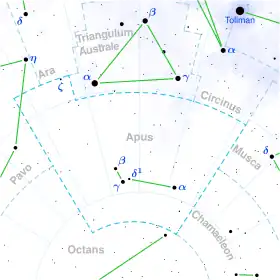 | |
| Observation data Epoch J2000 Equinox J2000 | |
|---|---|
| Constellation | Apus |
| Right ascension | 17h 22m 05.87559s[1] |
| Declination | –70° 07′ 23.5400″[1] |
| Apparent magnitude (V) | 5.41[2] (5.90/6.46)[3] |
| Characteristics | |
| Spectral type | B9 V + B9.5 V[3] |
| U−B color index | −0.23[2] |
| B−V color index | −0.04[2] |
| Astrometry | |
| Radial velocity (Rv) | −4.3[4] km/s |
| Proper motion (μ) | RA: −1.844 ± 0.266[5] mas/yr Dec.: −10.811 ± 0.303[5] mas/yr |
| Parallax (π) | 3.1403 ± 0.1782 mas[5] |
| Distance | 1,040 ± 60 ly (320 ± 20 pc) |
| Orbit[6] | |
| Period (P) | 59.32±3.0 yr |
| Semi-major axis (a) | 0.115±0.005″ |
| Eccentricity (e) | 0.172±0.050 |
| Inclination (i) | 69.4±3.0° |
| Longitude of the node (Ω) | 119.6±4.0° |
| Argument of periastron (ω) (secondary) | 270.5±7.0° |
| Details | |
| ι Aps A | |
| Mass | 3.89±1.02[6] M☉ |
| ι Aps B | |
| Mass | 3.45±0.90[6] M☉ |
| Other designations | |
| Database references | |
| SIMBAD | data |
Iota Apodis (ι Aps, ι Apodis) is the Bayer designation for a binary star[3] system in the southern circumpolar constellation of Apus. It is a faint target at an apparent visual magnitude of 5.41,[2] but still visible to the naked eye from suitably dark skies. The distance to this star can be roughly gauged from parallax measurements, yielding an estimate of 1,300 light-years (400 parsecs) with a 20% margin of error.[1]
Both stars are B-type main sequence stars, which indicates they shine with a blue-white hue.[8] The brighter component has a stellar classification of B9 V and an apparent magnitude 5.90, while the second member is a B9.5 V star with a magnitude of 6.46. The pair have an angular separation of 0.091 arcseconds[3] with an estimated orbital period of 59.32 years. They are about 3.89 and 3.45 times as massive as the Sun.[6]
Naming
In Chinese caused by adaptation of the European southern hemisphere constellations into the Chinese system, 異雀 (Yì Què), meaning Exotic Bird, refers to an asterism consisting of ι Apodis, ζ Apodis, β Apodis, γ Apodis, δ Octantis, δ1 Apodis, η Apodis, α Apodis and ε Apodis. Consequently, ι Apodis itself is known as 異雀二 (Yì Què èr, English: the Second Star of Exotic Bird.)[9]
References
- 1 2 3 van Leeuwen, F. (November 2007), "Validation of the new Hipparcos reduction", Astronomy and Astrophysics, 474 (2): 653–664, arXiv:0708.1752, Bibcode:2007A&A...474..653V, doi:10.1051/0004-6361:20078357, S2CID 18759600.
- 1 2 3 4 Nicolet, B. (1978), "Photoelectric photometric Catalogue of homogeneous measurements in the UBV System", Astronomy and Astrophysics Supplement Series, 34: 1–49, Bibcode:1978A&AS...34....1N.
- 1 2 3 4 Eggleton, P. P.; Tokovinin, A. A. (September 2008), "A catalogue of multiplicity among bright stellar systems", Monthly Notices of the Royal Astronomical Society, 389 (2): 869–879, arXiv:0806.2878, Bibcode:2008MNRAS.389..869E, doi:10.1111/j.1365-2966.2008.13596.x, S2CID 14878976.
- ↑ Wilson, Ralph Elmer (1953), "General Catalogue of Stellar Radial Velocities", Carnegie Institute Washington D.C. Publication, Washington: Carnegie Institution of Washington, Bibcode:1953GCRV..C......0W.
- 1 2 3 Brown, A. G. A.; et al. (Gaia collaboration) (August 2018). "Gaia Data Release 2: Summary of the contents and survey properties". Astronomy & Astrophysics. 616. A1. arXiv:1804.09365. Bibcode:2018A&A...616A...1G. doi:10.1051/0004-6361/201833051.
- 1 2 3 4 Docobo, J. A.; Andrade, M. (January 2013), "Dynamical and physical properties of 22 binaries discovered by W. S. Finsen", Monthly Notices of the Royal Astronomical Society, 428 (1): 321–339, Bibcode:2013MNRAS.428..321D, doi:10.1093/mnras/sts045.
- ↑ "* iot Aps". SIMBAD. Centre de données astronomiques de Strasbourg. Retrieved 2012-07-09.
{{cite web}}: CS1 maint: postscript (link) - ↑ "The Colour of Stars", Australia Telescope, Outreach and Education, Commonwealth Scientific and Industrial Research Organisation, December 21, 2004, archived from the original on March 18, 2012, retrieved 2012-01-16
- ↑ (in Chinese) AEEA (Activities of Exhibition and Education in Astronomy) 天文教育資訊網 2006 年 7 月 29 日